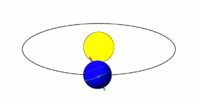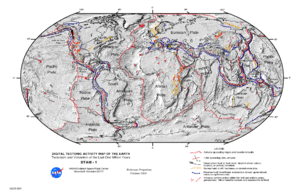Difference between revisions of "Earth"
m |
→What is plate tectonics? |
||
| (6 intermediate revisions by 2 users not shown) | |||
| Line 10: | Line 10: | ||
The Earth formed inside the accretion disc when the heavier particles started attracting smaller particles and began to clump together to eventually form a planet sized body. | The Earth formed inside the accretion disc when the heavier particles started attracting smaller particles and began to clump together to eventually form a planet sized body. | ||
=== How seasons on Earth work? === | === How seasons on Earth work? === | ||
| + | The seasons on Earth occur due to the current 23.5° axial tilt of the planet. As the Earth revolves around the Sun with its tilted axis, the amount of sunlight that reaches the northern and southern hemisphere varies over time. During the first half of the orbit during May, June, and July, the northern hemisphere will be tilted away from the sunlight. As the axial tilt remains fixed, the other half of the orbit during November, December, and January will be in a way that the northern hemisphere is tilted towards the sunlight. In between this, at vernal and autumnal equinoxes both the hemispheres will be facing the sun equally, forming spring and autumn respectively. | ||
| + | |||
=== Why Earth's axis is tilted? === | === Why Earth's axis is tilted? === | ||
| + | [[File:Earth_tilt_animation.gif|right|200px]] | ||
| + | The axial tilt of Earth is the result of the perturbations caused by the [[tidal force]]s of the moon. Large astronomical impacts of objects the size of a planet like [[Mars]] during the formation of the Earth is another plausible explanation for the tilt. The axial tilt of Earth is 24.5 degrees and it oscillates to 22.1 degrees every 41,000 years. | ||
| + | |||
=== What is plate tectonics? === | === What is plate tectonics? === | ||
| + | [[File:Plate Tectonics Map.gif|300px|thumb|right|Tectonic activity map of the Earth.]] | ||
| + | [[Plate tectonics]] is a geological concept that explains the formation of mountains and volcanoes. The theory is based on the geological observations and concepts rooted from the [[continental drift]] and [[seafloor spreading]] notions. It suggests that the Earth has a 100 km thick outer shell called [[lithosphere]], which is divided into larger and smaller tectonic plates. According to the plate tectonics observations, the earthquakes and formation of mountains and volcanoes are the results of these tectonic plates moving relative to each other. | ||
Latest revision as of 07:12, 16 March 2017
Contents
hideExplanation
Earth is the third planet from the Sun, which is where life as we know it thrives upon in this solar system. 4.5 billion years ago, Earth formed out of the gases and clouds of dust from the accretion disc of the solar nebula that created the solar system and the rest of the planets in it. Earth has a natural satellite, called as the Moon.
Frequently Asked Questions
Why does the Earth spin?
The Earth spins due to its inertia. Roughly, 4.5 billion years ago, when the hydrogen atoms in the solar nebula slowly collapsed down on its own gravity, a denser region formed at the centre of the cloud. As the distribution of the mass collapsed towards the centre, the spin of the entire cloud increased to conserve the angular momentum by nature. As it began to spin faster, it created the accretion disc where the protoplanets would form later. The hydrogen atoms and the particles in the disk inherited this spin too. Earth, being formed in the same way from the particles, it inherited its own average spin out of them. And by the law of inertia, Earth will continue to spin undisturbed until some unbalanced forces or any impacts would change its current state of motion.
How did the Earth form?
The Earth formed inside the accretion disc when the heavier particles started attracting smaller particles and began to clump together to eventually form a planet sized body.
How seasons on Earth work?
The seasons on Earth occur due to the current 23.5° axial tilt of the planet. As the Earth revolves around the Sun with its tilted axis, the amount of sunlight that reaches the northern and southern hemisphere varies over time. During the first half of the orbit during May, June, and July, the northern hemisphere will be tilted away from the sunlight. As the axial tilt remains fixed, the other half of the orbit during November, December, and January will be in a way that the northern hemisphere is tilted towards the sunlight. In between this, at vernal and autumnal equinoxes both the hemispheres will be facing the sun equally, forming spring and autumn respectively.
Why Earth's axis is tilted?
The axial tilt of Earth is the result of the perturbations caused by the tidal forces of the moon. Large astronomical impacts of objects the size of a planet like Mars during the formation of the Earth is another plausible explanation for the tilt. The axial tilt of Earth is 24.5 degrees and it oscillates to 22.1 degrees every 41,000 years.
What is plate tectonics?
Plate tectonics is a geological concept that explains the formation of mountains and volcanoes. The theory is based on the geological observations and concepts rooted from the continental drift and seafloor spreading notions. It suggests that the Earth has a 100 km thick outer shell called lithosphere, which is divided into larger and smaller tectonic plates. According to the plate tectonics observations, the earthquakes and formation of mountains and volcanoes are the results of these tectonic plates moving relative to each other.



